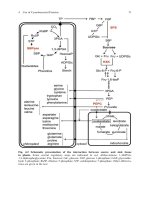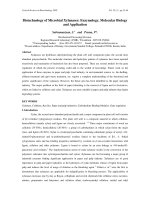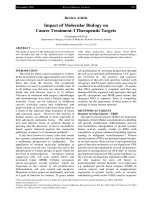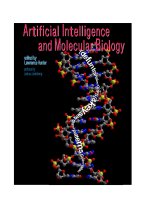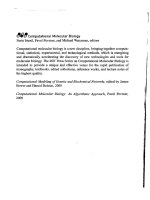Molecular Biology 5thRobert F WeaverChap 19
Bạn đang xem bản rút gọn của tài liệu. Xem và tải ngay bản đầy đủ của tài liệu tại đây (2.02 MB, 38 trang )
<span class='text_page_counter'>(1)</span>Lecture PowerPoint to accompany. Molecular Biology Fifth Edition. Robert F. Weaver Chapter 19 Ribosomes and Transfer RNA Copyright © The McGraw-Hill Companies, Inc. Permission required for reproduction or display..
<span class='text_page_counter'>(2)</span> 19.1 Ribosomes • The E. coli ribosome is a two-part structure with a sedimentation coefficient of 70S • Two subunits of this structure: – 30S is the small subunit that decodes mRNA – 50S subunit links amino acids together through peptide bonds. 19-2.
<span class='text_page_counter'>(3)</span> Fine Structure of 70S Ribosome • T. thermophilus crystal structure of 70S ribosome in complex with mRNA analog and 3 tRNAs shows: – Positions and tertiary structures of all 3 rRNA and most proteins can be determined – Shapes and locations of tRNAs in A, P, and E sites are evident – Binding sites for tRNAs in ribosome are composed of rRNA, not protein – Anticodons of tRNAs in A and P sites approach each other closely enough to base-pair with adjacent codons bound to 30S subunit as mRNA kinks 45° 19-3.
<span class='text_page_counter'>(4)</span> More Structural Detail • Acceptor stems of tRNAs in A and P sites also approach each other closely (5 Å) in the peptidyl transferase pocket of the 50S subunit • This is consistent with need for the two stems to interact during peptide bond formation • Twelve contacts are seen between subunits, most RNA-RNA interactions 19-4.
<span class='text_page_counter'>(5)</span> E. coli Ribosome Structure • Crystal structure of E. coli ribosome contains 2 structures differing from each other by rigid body motions of ribosome domains relative to each other – Head of 30S particle rotates by 6 – 12 rotation compared to T. thermophilus ribosome – Probably part of a ratchet action that occurs during translocation 19-5.
<span class='text_page_counter'>(6)</span> Eukaryotic Ribosomes • Eukaryotic cytoplasmic ribosomes are: – Larger – More complex. • Eukaryotic organellar ribosomes are smaller than prokaryotic ones. 19-6.
<span class='text_page_counter'>(7)</span> Ribosome Composition • The E. coli 30 subunit contains – 16S rRNA – 21 proteins (S1 – S21). • E. coli 50S subunit contains – 5S rRNA – 23S rRNA – 34 proteins (L1 – L34). • Eukaryotic cytoplasmic ribosomes are: – Larger – Contain more RNAs and proteins 19-7.
<span class='text_page_counter'>(8)</span> Fine Structure of the 30S Subunit • Sequence studies of 16S rRNA led to a proposal for secondary structure of the molecule • X-ray crystallography studies have confirmed the conclusions of these studies – 30S subunit with extensively base-paired 16S rRNA whose shape essentially outlines the whole particle – X-ray crystallography studies confirmed locations of most of the 30S ribosomal proteins 19-8.
<span class='text_page_counter'>(9)</span> Schematic representation of the ribosome. 19-9.
<span class='text_page_counter'>(10)</span> Interaction of the 30S Subunit with Antibiotics • 30S ribosomal subunit plays 2 roles – Facilitates proper decoding between codons and aminoacyl-tRNA anticodons – Also participates in translocation. • Crystal structures of 30S subunits with 3 antibiotics interfering with these 2 roles shed light on translocation and decoding – Spectinomycin – Streptomycin – Paromomycin 19-10.
<span class='text_page_counter'>(11)</span> Spectinomycin • Spectinomycin binds to 30S subunit near the neck • At this site, binding interferes with movement of the head • Head movement is required for translocation. 19-11.
<span class='text_page_counter'>(12)</span> Streptomycin • Streptomycin binds near the decoding center of 30S subunit • Binding stabilizes the ram state of the ribosomes • Fidelity of translation is reduced: – Allowing noncognate aminoacyl-tRNAs to bind easily to the decoding center – Preventing the shift to the restrictive state that is necessary for proofreading 19-12.
<span class='text_page_counter'>(13)</span> Interaction of streptomycin with the 30S ribosomal subunit. 19-13.
<span class='text_page_counter'>(14)</span> Paromomycin • Paromomycin binds in the minor groove of 16S rRNA H44 helix near the decoding center • This binding flips out bases A1492 and A1493 to stabilize base pairing between codon and anticodon – Flipping out process normally requires energy – Paromomycin forces it to occur and keeps the stabilizing bases in place. • State of the decoding center stabilizes codonanticodon interaction, including interaction between noncognate codons and anticodons, so fidelity declines 19-14.
<span class='text_page_counter'>(15)</span> Interaction of the 30S Subunit with Initiation Factors • X-ray crystal structure of IF1 bound to the 30S ribosomal subunit shows IF1 binds to the A site • In that position IF1: – Blocks fMet-tRNA from binding to the A site – May also actively promote fMet-tRNA binding to P site through interaction between IF1 and IF2. • IF1 also interacts closely with helix H44 of the 30S subunit • IF accelerates both association and dissociation of the ribosomal subunits 19-15.
<span class='text_page_counter'>(16)</span> Fine Structure of the 50S Subunit • Crystal structure of the 50S ribosomal subunit has been determined to 2.4 Å • Structure reveals relatively few proteins at interface between ribosomal subunits – No proteins within 18 Å of peptidyl transferase active center tagged with a transition state analog – 2’-OH group of tRNA in the P site is very well positioned to form a hydrogen bond to amino group of aminoacyl-tRNA in A site 19-16.
<span class='text_page_counter'>(17)</span> 2‘-Hydroxyl (2’-OH) Group Role • 2’-OH group of tRNA in the P site – Forms a hydrogen bond to amino group of aminoacyltRNA in A site – Helps catalyze peptidyl transferase reaction. • Removal of this hydroxyl group eliminates peptidyl transferase activity • Removal of the 2’-OH of A2451 of the 23S rRNA inhibits peptidyl transferase activity • May also participate in catalysis by: – Hydrogen bonding – Helping to position reactants properly for catalysis 19-17.
<span class='text_page_counter'>(18)</span> 50S Exit Tunnel Exit tunnel through the 50S subunit – Just wide enough to allow a protein -helix to pass – Walls of tunnel are made of RNA – Hydrophobicity is likely to allow exposed hydrophobic side chains of nascent polypeptide to slide through easily. 19-18.
<span class='text_page_counter'>(19)</span> Ribosome Structure and Mechanism of Translation • The mechanism of translation using the three-site model (A, P, E) of the ribosome is oversimplified • For example, aminoacyl-tRNAs can exist in hybrid states that do not confomr to the three-site model. 19-19.
<span class='text_page_counter'>(20)</span> Binding an aminoacyl-tRNA to the A Site • An aminoacyl-tRNA, upon binding to a ribosome, first enters the A/T state with it anticodon in the decoding site of the 30S particle, and its acceptor sten bound to EF-Tu, which forces a bend in the tRNA enhancing accuracy • Upon bending the tRNA loses contact with switch I of EF-Tu, allowing switch I to move, whch permits His 84 to enter the GTPase active center and hydrolyze GTP 19-20.
<span class='text_page_counter'>(21)</span> Binding an aminoacyl-tRNA to the A Site • Upon GTP hydrolysis, EF-Tu-GDP leaves the ribosome allowing the aminoacyl-tRNA to enter the A/A site. • This rearrangement in turn causes a conformational shift in the ribosome that releases the deacylated tRNA from the E site. 19-21.
<span class='text_page_counter'>(22)</span> Translocation • Translocation begins with the spontaneous ratcheting of the 30S particle with respect to the 50S particle, which brings the tRNAs into hybrid A/P and P/E states • Upon EF-G-GTP binding and hydrolysis of GTP, the tRNA and mRNA translocate on the 30S particle to enter the classical P and E sites, and the ratchet resets 19-22.
<span class='text_page_counter'>(23)</span> Interaction of the 70S Ribosome with RF1 • RF1 domains 2 and 3 fill the codon recognition site and the peptidyl transferase site, respectively, of the ribosome’s A site, in recognizing the UAA stop codon • The “reading head” portion of domain 2 of RF1 occupies the codon recognition site within the A site and collaborates with A142 of the 16S rRNA to recognize the stop codon • The universally conserved GGQ motif at the tip of domain 3 closely approaches the peptidyl transferase center and participates in cleavage of the ester bond linking the completed polypeptide to the tRNA 19-23.
<span class='text_page_counter'>(24)</span> Interaction of the 70S Ribosome with RF2 • RF2 binds to the ribosome in much the same way in response to the UGA stop codon • Its SPF motif, which corresponds to the PXT motif in RF1, is in position to recognize the stop codon, in collaboration with other residues in RF2 and the 16S rRNA • Its GGQ motif is at the peptidyl transferase center, where it can participate in cleavage of the polypeptide-tRNA bond, which terminates translation 19-24.
<span class='text_page_counter'>(25)</span> Polysomes • Most mRNAs are translated by more than one ribosome at at time • A structure in which many ribosomes translate mRNA in tandem is called a polysome • Eukaryotic polysomes are found in the cytoplasm • In prokaryotes, transcription of a gene and translation of the resulting mRNA occur simultaneously • Many polysomes are found associated with an active gene 19-25.
<span class='text_page_counter'>(26)</span> 19.2 Transfer RNA • An adaptor molecule was proposed that could serve as a mediator between the string of nucleotides in DNA or RNA and the string of amino acids in the corresponding protein • The adaptor contained 2 or 3 nucleotides that could pair with nucleotides in codons. 19-26.
<span class='text_page_counter'>(27)</span> The Discovery of tRNA • Transfer RNA (tRNA) was discovered as a small species independent of ribosomes • This small species could be charged with an amino acid • That species could then pass the amino acid to a growing polypeptide. 19-27.
<span class='text_page_counter'>(28)</span> tRNA Structure • All tRNAs share a common secondary structure represented by a cloverleaf • Four base-paired stems define three stemloops – D loop – Anticodon loop – T loop. • The acceptor stem is the site to which amino acids are added in the charging step 19-28.
<span class='text_page_counter'>(29)</span> The cloverleaf structure of tRNA. 19-29.
<span class='text_page_counter'>(30)</span> tRNA Shape • tRNAs share a common three-dimensional shape resembling an inverted L • This shape maximizes stability by lining up the base pairs: – In the D stem with those in the anticodon stem – In the T stem with those in the acceptor stem. • Anticodon of the tRNA protrudes from the side of the anticodon loop – Anticodon is twisted into a shape that basepairs with corresponding codon in mRNA 19-30.
<span class='text_page_counter'>(31)</span> Modified Nucleosides in tRNA. 19-31.
<span class='text_page_counter'>(32)</span> Recognition of tRNA Acceptor Stem • Biochemical and genetic experiments have demonstrated the importance of the acceptor stem in recognition of a tRNA by its cognate aminoacyl-tRNA synthetase • Changing one base pair in the acceptor stem can change the charging specificity. 19-32.
<span class='text_page_counter'>(33)</span> The ribosome responds to the tRNA, not the attached amino acid. 19-33.
<span class='text_page_counter'>(34)</span> The Anticodon • Biochemical and genetic experiments have shown that anticodon, like acceptor stem, is an important element in charging specificity • Sometimes the anticodon can be the absolute determinant of specificity. 19-34.
<span class='text_page_counter'>(35)</span> Structures of Synthetase-tRNA Complexes Crystallography has shown that synthetasetRNA interactions differ between the 2 classes of aminoacyl-tRNA synthetases – Class I synthetases • Pockets for acceptor stem and anticodon of their cognate tRNA • Approach the tRNAs from the D loop and acceptor stem minor groove side. – Class II synthetases • Also have pockets for acceptor stem and anticodon • Approach tRNA from opposite including the variable arm and the major groove of the acceptor stem. 19-35.
<span class='text_page_counter'>(36)</span> Proofreading and Editing Amino acid selectivity of at least some aminoacyltRNA synthetases is controlled by a double-sieve mechanism – 1st sieve is coarse excluding amino acids too big • Enzyme accomplishes this with an active site for activation of amino acids just big enough to accommodate the cognate amino acid, not larger amino acids. 19-36.
<span class='text_page_counter'>(37)</span> Proofreading and Editing Amino acid selectivity of at least some aminoacyltRNA synthetases is controlled by a double-sieve mechanism – 2nd sieve degrades too small aminoacyl-AMPs • Done with a second active site, the editing site, admits small aminoacyl-AMPs and hydrolyzes them • Cognate aminoacyl-AMP is too big to fit into the editing site • Enzyme transfers the activated amino acid to its cognate tRNA. 19-37.
<span class='text_page_counter'>(38)</span> The double sieve. 19-38.
<span class='text_page_counter'>(39)</span>
